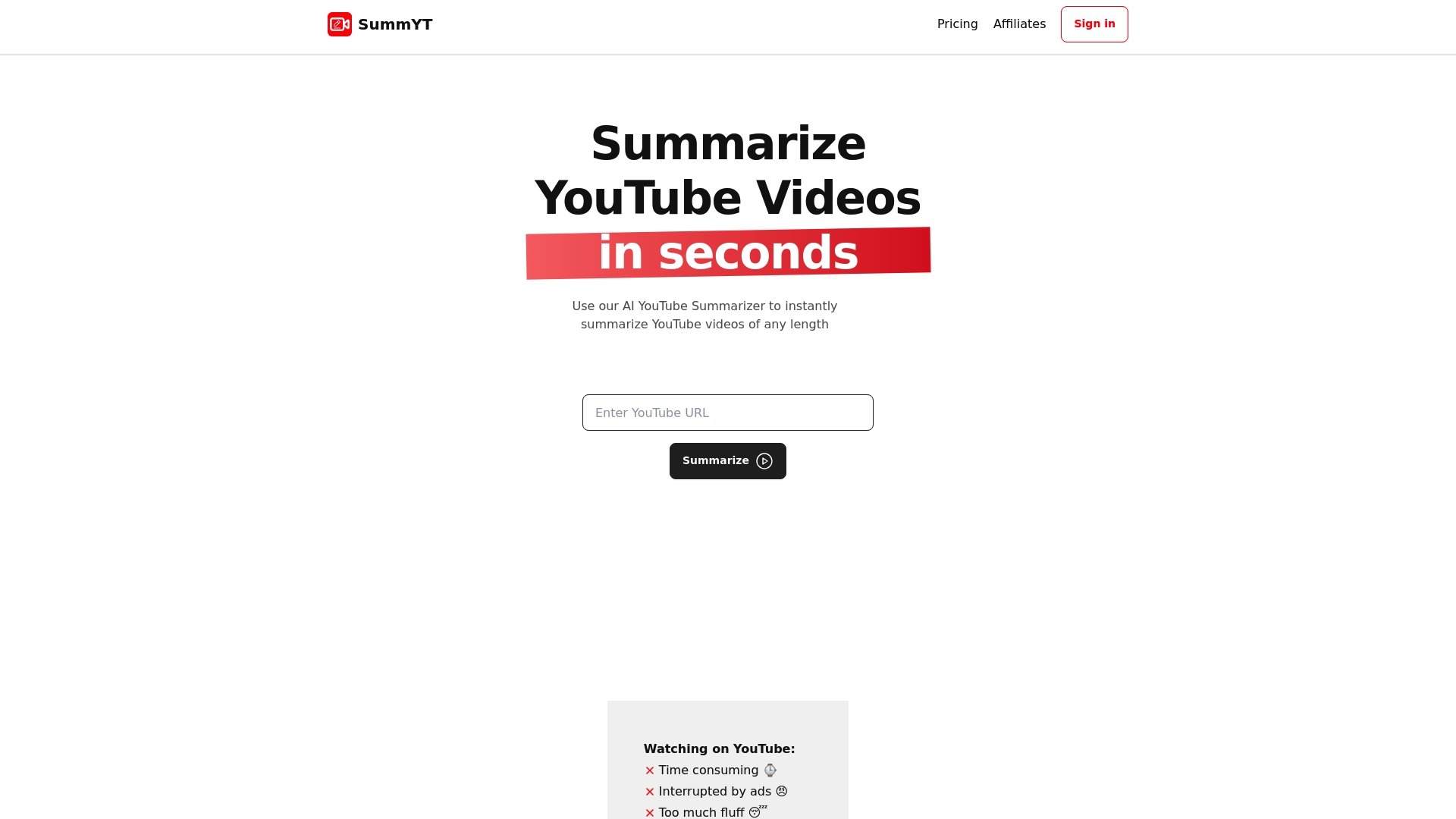7 Essential Examples of Content Summarizers for 2025

Everyone complains about how much reading or watching we have to do online and content just keeps piling up. But most people have no idea that there are digital tools smart enough to turn a two-hour video or a 20-page article into a short summary in seconds. The real shock is that advanced content summarizers now use AI so powerful, they can reduce your reading time by over 80 percent while actually improving your comprehension.
Table of Contents
- What Is A Content Summarizer?
- Why Use Content Summarizers?
- Example 1: Automated Summarization Tools
- Example 2: Manual Summarization Techniques
- Example 3: AI-Powered Summarizers
- Example 4: Visual Summarization Methods
- Example 5: Podcast And Video Summarizers
Quick Summary
| Takeaway | Explanation |
|---|---|
| Content summarizers enhance productivity. | They help users streamline information processing, making it easier to absorb essential insights quickly. |
| Automated tools utilize advanced AI. | These tools employ machine learning to create concise summaries that maintain the original context of the material. |
| Manual summarization enhances comprehension. | This technique requires critical engagement with content, allowing for better understanding and retention of complex information. |
| AI-powered summarizers capture nuance. | These tools generate contextually rich summaries, understanding both literal meaning and underlying intent of texts. |
| Visual methods simplify complex data. | By translating multimedia information into clear visuals, these methods enhance understanding and rapid comprehension of intricate concepts. |
1: What is a Content Summarizer?
A content summarizer is an advanced digital tool designed to transform lengthy texts, articles, videos, or documents into concise, precise summaries that capture the most critical information. These intelligent systems utilize sophisticated algorithms and artificial intelligence to analyze, extract, and synthesize key insights without losing the original context or meaning.
Content summarizers fundamentally work by breaking down complex information into digestible formats, helping users save time and improve comprehension. According to research from Mozilla’s Developer Network, these tools employ advanced computational linguistics and machine learning techniques to identify central themes and important details.
The primary functions of a content summarizer include:
- Extracting key points from extensive documents
- Reducing reading time by presenting concentrated information
- Preserving original context while minimizing unnecessary details
- Supporting multiple content formats including text, video, and audio
Professionals across various domains leverage content summarizers to enhance productivity and knowledge absorption. From researchers and students to corporate executives and journalists, these tools provide a strategic approach to managing information overload. Read our comprehensive guide on AI summarization tools to explore how these technologies are transforming information consumption.
By converting complex information into clear, concise summaries, content summarizers represent a significant advancement in how we process and understand digital content.
2: Why Use Content Summarizers?
Content summarizers have become essential tools in our information-saturated world, addressing critical challenges of information overload and inefficient knowledge consumption. These powerful technologies offer transformative solutions for professionals, students, and researchers seeking to optimize their learning and productivity.
According to research from the U.S. Department of Education, summarization techniques dramatically enhance comprehension by helping individuals focus on and connect core ideas quickly and effectively.
The primary motivations for using content summarizers include:
- Time efficiency: Condensing hours of reading or watching content into minutes
- Enhanced comprehension: Extracting key insights without losing critical context
- Knowledge retention: Presenting information in a structured, memorable format
- Accessibility: Making complex information more digestible for diverse audiences
Professionals across multiple domains leverage these tools to streamline information processing. Researchers rapidly review academic papers, journalists quickly analyze lengthy reports, and students efficiently study complex subjects. Learn more about summarization strategies for educational content to maximize learning potential.
Moreover, content summarizers represent a strategic response to the exponential growth of digital information. By filtering signal from noise, these tools help individuals make informed decisions faster, reduce cognitive load, and maintain a competitive edge in fast-paced professional environments.
3: Example 1: Automated Summarization Tools
Automated summarization tools represent the cutting edge of content processing technology, utilizing advanced artificial intelligence to transform extensive documents into concise, meaningful summaries. These sophisticated systems leverage machine learning algorithms to analyze and distill complex textual information with remarkable precision.
According to research from computational linguistics experts, these tools predominantly employ two primary summarization techniques: extractive and abstractive approaches. Extractive methods identify and extract the most significant sentences from the original text, while abstractive techniques generate entirely new sentences that capture the core meaning.
Key characteristics of automated summarization tools include:
- Natural language processing capabilities that understand context and semantic nuances
- Multilingual support enabling summaries across different languages
- Adaptability to various document types including academic papers, news articles, and technical reports
- Customizable summary lengths to match user preferences
The technological sophistication of these tools allows them to go beyond simple text truncation. They analyze document structure, identify key themes, and reconstruct information in a manner that preserves original intent and critical details. Explore advanced summarization strategies for professional contexts to understand their transformative potential.
Modern automated summarization tools are not just about shortening text but about intelligent information distillation. They represent a powerful solution for professionals drowning in information, offering a strategic approach to consuming and understanding complex content quickly and effectively.
4: Example 2: Manual Summarization Techniques
Manual summarization techniques represent a traditional yet powerful approach to content distillation, requiring human critical thinking and analytical skills to extract core ideas from complex texts. These methods demand active engagement and strategic information processing that goes beyond algorithmic approaches.
According to research from academic studies, manual summarization involves deliberate cognitive strategies that help learners deeply understand and restructure information. Unlike automated tools, these techniques rely on human judgment and contextual understanding.
Key manual summarization techniques include:
- Highlighting key passages and identifying central themes
- Paraphrasing critical information in concise, original language
- Creating structured notes that capture essential arguments
- Developing conceptual mind maps to visualize relationships between ideas
Professional researchers, students, and academics frequently employ these techniques to engage more deeply with complex materials. Manual summarization requires practitioners to critically analyze text, distinguish between primary and secondary information, and reconstruct knowledge in a meaningful way. Learn more about effective video content summarization strategies to enhance your understanding.
While more time-consuming than automated methods, manual summarization techniques offer unparalleled depth of comprehension. They train individuals to become more sophisticated information processors, developing critical thinking skills that extend far beyond simple text reduction.
5: Example 3: AI-Powered Summarizers
AI-powered summarizers represent the most advanced frontier of content distillation technology, leveraging sophisticated machine learning models to generate incredibly precise and contextually nuanced summaries. These cutting-edge tools go beyond traditional algorithmic approaches, employing deep neural networks that can understand semantic complexity and generate human-like condensed content.
According to research from the Journal of Supercomputing, these AI models utilize advanced techniques like word embedding, semantic analysis, and contextual feature extraction to create summaries that capture not just the literal meaning, but the underlying intent of the original text.
Key characteristics of AI-powered summarizers include:
- Natural language generation that mimics human writing style
- Multi-language support enabling cross-linguistic summarization
- Adaptive learning that improves summary quality with continued use
- Contextual understanding beyond simple keyword matching
These technologies represent a significant leap forward in information processing. Unlike traditional summarization methods, AI-powered tools can understand nuanced context, recognize implicit connections, and generate summaries that feel remarkably organic. Explore how AI transforms content summarization to grasp their transformative potential.
AI-powered summarizers are not just tools but intelligent assistants that help professionals, researchers, and learners navigate the overwhelming sea of digital information with unprecedented efficiency and depth of understanding.
6: Example 4: Visual Summarization Methods
Visual summarization methods represent an innovative approach to content distillation that transforms complex multimedia information into concise, visually compelling representations. These techniques go beyond traditional text-based summarization by leveraging advanced machine learning algorithms to extract and synthesize key visual elements from images, videos, and graphical content.
According to research from computational imaging studies, these methods employ sophisticated techniques like generative adversarial networks and saliency-based analysis to identify and highlight the most significant visual information in a given dataset.
Key characteristics of visual summarization methods include:
- Intelligent image selection that prioritizes most meaningful visual content
- Spatiotemporal feature extraction from video and multimedia sources
- Automated layout generation creating intuitive visual narratives
- Multi-modal integration combining text and visual information seamlessly
Visual summarization serves critical functions across multiple domains, from research and education to marketing and media production. Professionals can rapidly comprehend complex information through strategically curated visual representations that capture the essence of extensive multimedia content. Explore advanced video content summarization techniques to understand their transformative potential.
By translating complex information into visually digestible formats, these methods represent a powerful tool for knowledge compression and rapid comprehension in our increasingly visual and information-rich world.
7: Example 5: Podcast and Video Summarizers
Podcast and video summarizers represent a sophisticated technological solution for transforming lengthy multimedia content into concise, easily digestible insights. These innovative tools leverage advanced natural language processing and machine learning algorithms to extract the most critical information from audio and video sources.
According to research from Microsoft Research, these summarization technologies analyze multiple signals including speech patterns, contextual cues, and semantic content to generate accurate and meaningful summaries.
Key capabilities of podcast and video summarizers include:
- Automatic transcription of spoken content with high accuracy
- Semantic analysis that identifies core themes and arguments
- Time-stamped key moments extraction from multimedia content
- Multilingual support enabling cross-language comprehension
These tools serve professionals across diverse domains, from journalists and researchers to students and corporate trainers. By condensing hours of multimedia content into brief, informative summaries, they dramatically reduce information consumption time while maintaining critical context. Discover advanced video summarization techniques for field reporting to understand their transformative potential.
Podcast and video summarizers are not merely technological tools but intelligent knowledge management systems that help individuals navigate the overwhelming landscape of digital multimedia content with unprecedented efficiency and precision.
The table below provides a comprehensive summary of the article, organizing the main types of content summarizers, their core features, and the key benefits they offer for productivity and comprehension.
| Type of Summarizer | Core Features | Key Benefits |
|---|---|---|
| Automated Summarization Tools | Uses AI to extract or abstract main ideas; customizable summary lengths; supports multiple formats | Saves time; preserves original meaning; fast document review |
| Manual Summarization Techniques | Human-driven; involves paraphrasing, note-taking, and mind maps | Deep comprehension; improved retention; critical thinking |
| AI-Powered Summarizers | Advanced machine learning; natural language generation; contextual understanding | Accurate, nuanced summaries; adapts over time |
| Visual Summarization Methods | Intelligent image/video selection; integrates visuals and text; automated layout | Simplifies complex data; enables rapid understanding |
| Podcast and Video Summarizers | Transcribes audio; analyzes speech and context; timestamps key moments | Condenses hours of multimedia; maintains critical context |
| General Benefits (All Types) | Time efficiency; enhances comprehension and accessibility; supports knowledge retention | Reduces cognitive load; helps manage information overload |
| Use Cases/Applications | For professionals, students, researchers, journalists, executives across industries | Streamlines learning, reporting, and research tasks |
Turn Endless Videos Into Smart, Actionable Summaries with SummYT
Have you ever felt overwhelmed by the sheer volume of videos you need to watch just to get the essential information? The article “7 Essential Examples of Content Summarizers for 2025” shows how advanced summarization methods can save hours, sharpen focus, and help with fast knowledge absorption—especially when facing long podcasts, lectures, or webinars that eat up precious time. When fatigue and information overload make it hard to keep up, you need a real-world solution built for today’s content demands.

Experience what AI-powered video summarization really feels like with SummYT. Extract the most relevant insights from any YouTube video so you can skip the fluff and get straight to what matters. Whether you are a student, a professional, or a lifelong learner, SummYT helps you cover more ground in less time. Ready to reclaim your hours and boost your understanding? Try smart video summaries now at SummYT and see the difference for yourself.
Frequently Asked Questions
What is a content summarizer?
A content summarizer is a digital tool that transforms lengthy texts, articles, videos, or documents into concise summaries, capturing critical information while preserving the original context.
How do automated summarization tools work?
Automated summarization tools utilize advanced artificial intelligence and machine learning algorithms to analyze and distill complex textual information into meaningful summaries, typically using extractive and abstractive techniques.
What are the benefits of using manual summarization techniques?
Manual summarization techniques involve critical thinking and human judgment, allowing individuals to engage deeply with content, extract core ideas, and develop structured notes or visualizations, enhancing comprehension.
What makes AI-powered summarizers different from traditional methods?
AI-powered summarizers leverage deep learning models to understand semantic complexity, generate human-like content, and provide contextually nuanced summaries, unlike traditional methods that may rely on simpler algorithmic approaches.



